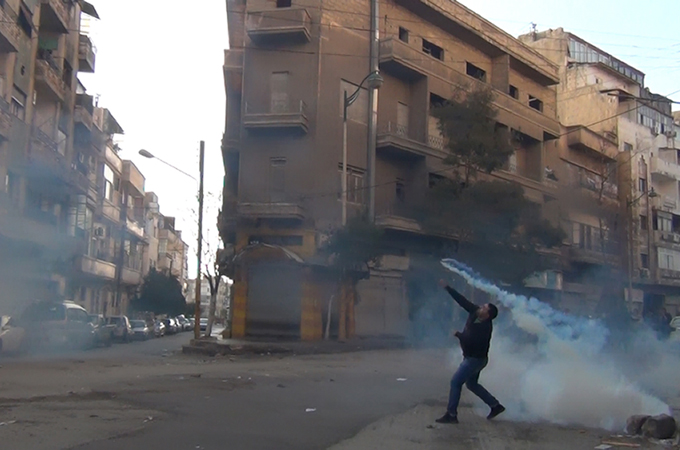By Adom M. Cooper
Impunity Watch Reporter, Middle East
DAMASCUS, Syria–Arab League monitors have arrived in Syria to observe three key protest sites as the international community urges al-Assad’s regime to allow full access to the country. The observers must be able to adequately determine if the country is implementing a plan to end crackdowns on demonstrations and protests.

The UN has stated that more than 14,000 people are in detention and estimated that more than 5,000 people have been killed in the government crackdown since anti-government demonstrations and protests began earlier this year in mid-March.
All of the detained demonstrators and protesters should be freed under a peace plan created by the Arab League.
Anti-government protests festered violence that continued on Wednesday 28 December 2011. Video shared by activists depicted the central city of Hama with gunshots being fired and black smoke rising above the city.
Dozens of men were seen marching through the streets, chanting and shouting, “Where are the Arab monitors?”
More violence was reported in the southern province of Deraa, where the Britian-based Syrian Observatory for Human Rights stated that army defectors killed at least four Syrian soldiers. The organization also reported that at least one person was killed in the city of Homs.
On Tuesday 27 December 2011, activists stated that Syrian police used tear gas to disperse an estimated 70,000 people who took to the streets of Homs as the monitors arrived. Some demonstrators were fired upon with live ammunition as they made their way to Sa’a square, and four were wounded, one of them critically.
Before joining the march on Al-Sa’a square, some tens of thousands of protesters staged a sit-in in the al-Khalidiyeh neighborhood, according to the Syrian Observatory for Human Rights. There were also demonstrations that took place in the Bab Dreib and Jub al-Jandalia districts of the country. On Monday 26 December 2011, at least 34 civilians were reportedly killed in Homs’ Baba Amro district. T
Mustafa al-Dabi, the head of the Arab League’s mission, stated on Wednesday 28 December 2011, that monitors would head to Hama and to Iblib, on Syria’s nortern border with Turkey. These two areas have endured intense fighting between security forces and fighters who support the protesters. al-Dabi shared these words with Al-Jazeera about the monitors’ arrival.
“Yesterday was quiet and there were no clashes. We did not see tanks but we did see some armored vehicles. There were some places where the situation was not good. But there wasn’t anything frightening, at least while we were there. But remember, this was only the first day and it will need investigation. We have 20 people who will be there for a long time.”
The Arab League plan endorsed by Syria on 2 November calls for the withdrawal of the military from towns and residential districts, a halt in violence against civilians, and the release of detainees. A Syrian security officer in Homs told Human Rights Watch (HRW), a US-based rights organization, that after the government signed the Arab League protocol authorizing the observer mission, between 400 and 500 prisoners were moved out of his facility to other places of detention, including a nearby missile factory in Zaidal. The official shared these words with HRW.
“The transfers happened in installments. Some detainees were moved to civilian jeeps and some in cargo trucks. My role was inside the prison, gathering the detainees and putting them in the cars. My orders from the prison director were to move the important detainees out.”
Other witnesses corroborated the official’s account. HRW spoke with a detainee who claimed that a transfer of other detainees took place from the Military Security detention facility in Homs on the night of 19 December.
“There were about 150 detainees. They took them out around 1:30 or 2:00 in the morning. These guys were in detention the longest. Not criminals, but people who worked with journalists, or were defectors, or involved in protests.”
HRW has accused al-Assad’s regime of hiding from the monitors hundreds of detainees held in its crackdown on dissent. HRW’s Middle East director Sarah Leah Whitson released a statement about the hiding of detainees.
“Syria’s subterfuge makes it essential for the Arab League to draw clear line regarding access to detainees, and be willing to speak out when those lines are crossed. Syrian authorities have transferred perhaps hundreds of detainees to off-limits military sites to hide them from Arab League monitors now in the country.”
Sergei Lavrov, the Russian foreign minister, has urged Syria to give the monitors the maximum amount of freedom as they move throughout the country to complete their mission.
“We constantly work with the Syrian leadership calling on it to fully cooperate with observers from the Arab League and to create work conditions that are as comfortable and free as possible.”
The Local Coordination Committees in Syria stated that seven people had been killed so far on Wednesday 28 December 2011, four in Homs, two in Hama, and one in Aleppo.
The ban on international journalists in Syria continues to be in effect, making it increasingly difficult to independently verify casualty figures and other information.
For more information, please see:
Ahram – Observers to Deploy in More Syria Protest Hubs – 28 December 2011
Al-Jazeera – Arab Monitors in Syria Flashpoint Towns – 28 December 2011
BBC – Syria ‘Release 755 Detained During Unrest – 28 December 2011
Reuters – ‘Nothing Frightening’ Seen in Syria Protest Hotbed – 28 December 2011
The Guardian – Arab League Monitors Visit Homs – 27 December 2011
Human Rights Watch – Syria: Detainees Hidden From International Monitors – 27 December 2011